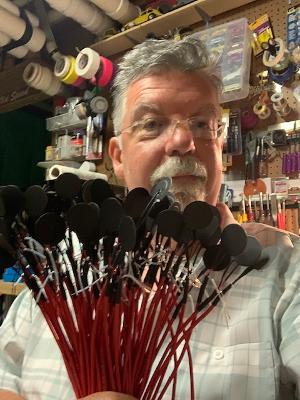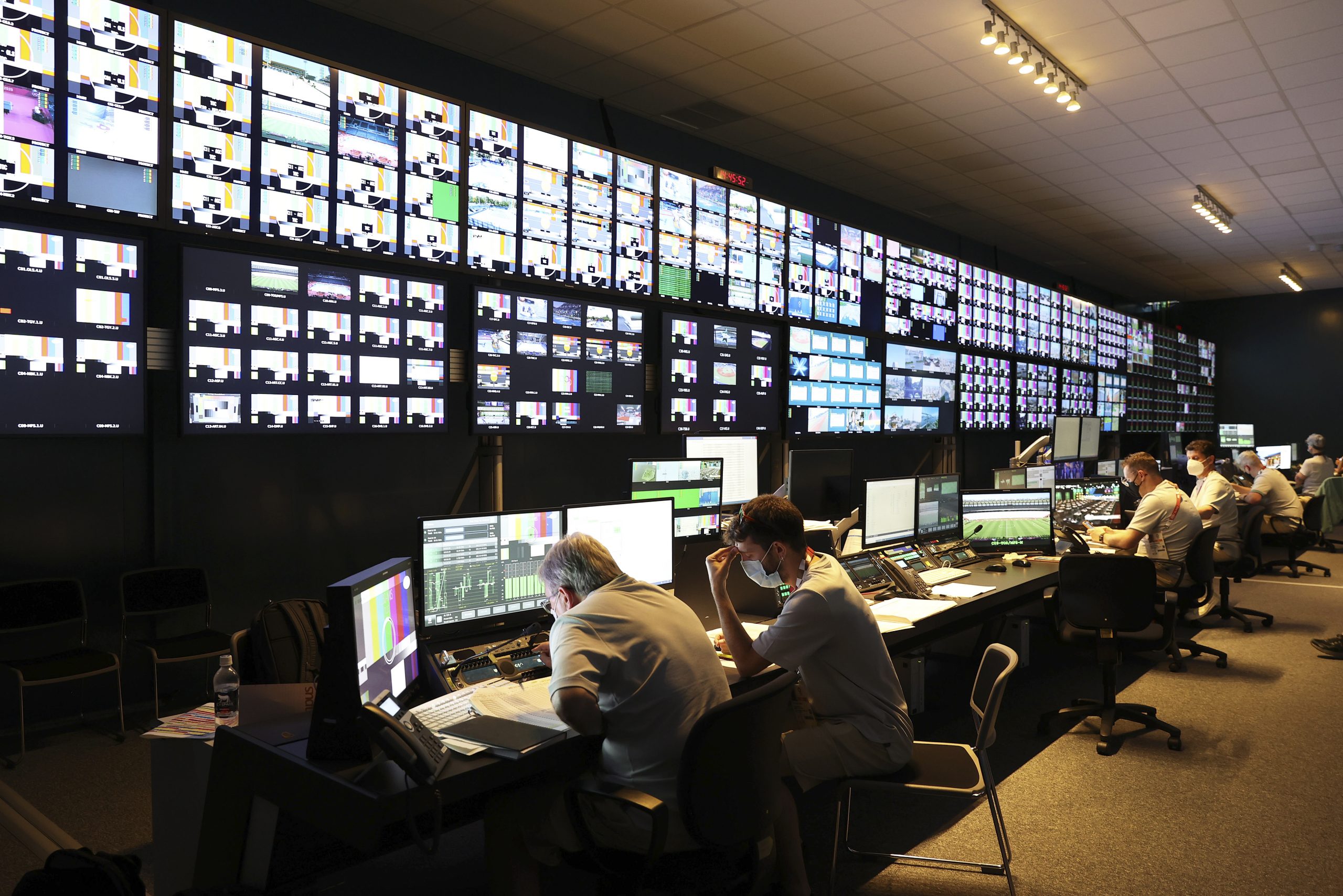SVG SportSound Year in Review: COVID Continued To Drive Innovation
Sports returned to home venues, but REMI still played a major role
Story Highlights
2021 was supposed to be the year that wasn’t 2020. Instead, it became the year that broadcast-sports audio learned to live with COVID.
No sport better exemplified that than basketball. The previous year’s NBA season debuted the use of “enhanced” ambient crowd sounds by U.S. sports to make games played under pandemic lockdown feel more authentic. The 2021 NBA season aimed to replicate the success of that effort as teams returned to their respective arenas.
“Last season was challenging, and this season is going to be even more so,” Dave Grundtvig, lead A1 for Turner Sports’ NBA coverage, said as the season was about to commence.

A1 Dave Grundtvig: “We learned that doing a show from an empty arena was like working on a sound stage.”
Among the changes for the 2021 NBA season was full REMI audio production, with mixes done from Turner Sports’ Atlanta studios and the use and operation of augmented crowd sounds left to individual teams’ discretion.
The NHL, which in 2020 deployed a crowd-sound system developed by EA Sports and other partners, last year used the same Launchpad-based controller as the NBA, with audio sources based on venue- and team-specific recordings. The sound was played through the hockey arenas’ existing PA systems. Both leagues also mandated that the virtualized crowd sound be played as part of game-broadcast audio.
The 2021 NCAA March Madness event showed how sports audio could be a hybrid of real and augmented crowd sound. About 6,000 spectators were allowed into Lucas Oil Field House, and actual crowd noise from six ambience microphones was mixed in with Firehouse Productions’ crowd-sound system fed into the venue’s PA system.
Augmented crowd sound is arguably the most notable audio development of the current century (sorry, AutoTune). Although it came about because of the pandemic, it will likely leave a lasting impression, both because the arrival of the Omicron variant late in 2021 meant that sports venues might once again limit audiences and because COVID-emptied venues allowed an entirely new soundscape to emerge, one that viewers would come to want more of.
“We learned in Orlando that doing a show from an empty arena was like working on a sound stage,” explained Grundtvig. “It’s not the same sound as when all of the microphones are open: the key mic, the net mic, the bench and camera mics.”
Effects on Other Audio
As the pandemic drove REMI-type production techniques, it also affected evolution of the technologies underpinning them. For instance, intercoms moved much deeper into IP environments as broadcast technicians were increasingly compelled to work from locations other than the venue.
“REMI got REMI-ed” is how Rick Seegull, manager, system consulting, Riedel Communications, expressed it. IP-based and, more recently, app-based intercom solutions moved from interim, temporary solutions to more-established elements of suddenly disrupted broadcast workflows. “And that’ll be the case for a while to come,” he added, “so our remote offerings are based on keeping the workflow identical, whether in the control room or at-home/remote.”
Said Pliant VP, Global Sales, Gary Rosen, “There were fewer productions earlier in the year and more people working remotely with less onsite technical staff, which increased the need for reliable, high-quality, easy-to-use intercom. Before, you might have been able to [talk directly] to a nearby colleague; now, suddenly, you had to stay distanced, even in the same room.”
Immersive Sound
The accelerated arrival of immersive audio was the year’s other significant note. In February, the Audio Engineering Society presented the first-ever AES Immersive Audio Academy, a one-day online event that looked at the diverse applications of immersive-audio production.

Produced by Olympic Broadcasting Services, the 2020 Tokyo Summer Games were the first-ever Olympics to use artificial crowd noise.
But the star of the immersive show was the Tokyo Olympics, the first Olympics broadcast in 5.4.1 immersive audio, with four overhead channels adding an upper dimension to the indoor events.
“Immersive sound is our biggest challenge, because it’s new for 99% of the A1s and broadcast engineers,” said Nuno Duarte, senior manager, audio, Olympic Broadcasting Services (OBS), from the International Broadcast Center (IBC) in Tokyo.
The OBS captured the sounds of the Olympics through an immersive 5.1.4 audio configuration whose overhead dimension came with the addition of four hanging ceiling microphones and with two new microphones — using 4.0 and 8.0 transducer configurations — specifically designed for immersive-audio production.
Because of last-minute COVID restrictions imposed by the Japanese government barring spectators from most venues, it was also the first-ever Olympics to use some form of artificial crowd noise. The implementation at the Olympics was minimal, limited to pre-recorded “murmur” tracks, whose content is derived from archived event sound tracks and played through the venue PA systems and also picked up by the broadcast microphones.
Last year’s Summer Games also had a number of other innovations, such as placing contact microphones on the water-polo goalposts to catch the sound of the near misses and capture as much high-impact sound as possible.
Immersive audio wasn’t forgotten during pandemic lockdowns either. For instance, the UK’s Sky Sports used Dolby Atmos throughout Project Restart, the return of sports to television, broadcasting Premier League and English Football League (EFL) matches.
Training Takes Center Stage
Training took on a new emphasis last year as, like sports productions themselves, it had to go remote. Manufacturers stepped up to the challenge, with virtual programs like Calrec’s Sound Institute, Lawo Online Academy, Shure Audio Institute, and Wheatstone’s VoxPro Academy.
But that only highlighted a much deeper problem facing broadcast audio: a lack of development of the next generation of A1s as the current cohort retired. Tom Sahara, former Turner Sports VP, operations and technology, and past chairman of SVG and DTVAG industry working groups, noted how programs that try to address that had been derailed first by ongoing media-industry consolidations and then by COVID, which pushed many A1s to advance their retirement due to restrictive work environments and the precariousness of travel. The shortage, he said, “went from bad to worse.”
Industry members continued seeking solutions. For instance, Program Productions last year established its own training program in which A1 candidates shadow and learn from veteran broadcast mixers. However, Program Productions CEO Bob Carzoli stressed that, to be successful, any solution has to be supported by the entire industry. The current A1 situation simply has no short-term fix and is, as he put it, “labor management going from checkers to chess.”
Supply-Chain Blues
Another singular situation made 2021 an eventful year. Supply-chain problems beset global manufacturing after the pandemic closed down much of the world’s manufacturing and transport, and the microchip supply ecosystem critical to digital audio products and systems was especially affected. It resulted in such situations as a reported 61-week lag time for capacitors, a component necessary for every audio console on earth.
In response, manufacturers muscled up their own parts-manufacturing capabilities. For instance, Wheatstone made a million-dollar investment in large component buys and new factory equipment at its manufacturing facility in New Bern, NC. Calrec redesigned and upgraded its Hebden Bridge, West Yorkshire, UK, production facility for a more flexible manufacturing process: all parts of the process are mobile so manufacturing flow can remain agile, and, with additional test facilities introduced at more points in the assembly process, workspaces also operated as multifunctional test zones.
Music in and on the Air
The NHL signed an exclusive deal with APM Music in which the Hollywood-based production-music supplier will provide all the music used by the league and its 32 teams for broadcast, in-venue, commercial, promotional, and social-media applications, collectively and individually.
What APM Music Director, Sports Entertainment, Matthew Gutknecht described as “the soundtrack for a new era in the NHL for the next seven years” is also a hedge against possible IP infringements. Litigation between sports leagues and broadcasters and music publishers has become more frequent in recent years as the explosion in outlets and amount of sports media on the air and online creates more potential for unintended copyright infringements. For instance, music during a game that might be properly licensed for live use in an arena but leaking into a broadcast of the game could constitute an unintended — but nonetheless very real, legally speaking — copyright infringement.
Last year saw a bevy of sonic innovations in other areas as well. For instance, Turner Sports’ new deal with the NBA brought with it the implementation of multiple Shure MX710 linear-array microphone assemblies in key locations in arenas. A rectangular array, originally intended for use mainly in corporate-meeting or education applications, was mounted on each backboard and in front of the announcers’ table. Remotely steerable, the arrays allowed broadcast A1s to keep the microphone lobes focused on the play as it moved around the court.
ESPN, meanwhile, deployed an array of three RF lav mics in an L-C-R configuration to create a surround-type sonic environment around NHL goals, enabling the announcer audio to remain clear and intelligible without sacrificing any effects dynamics around scores.
Although everyone is relieved to have 2021 in the rearview mirror, it’s also clear that the pandemic, combined with numerous technical innovations and developments, points to an equally challenging — and potentially rewarding — 2022. It might be, as late Yankees shortstop and announcer Phil Rizzuto liked to say when there were two on and two out, “It’s deuces wild.”
